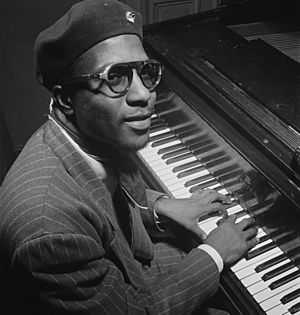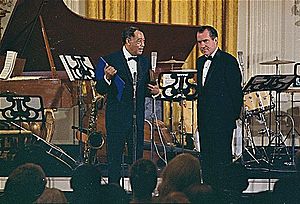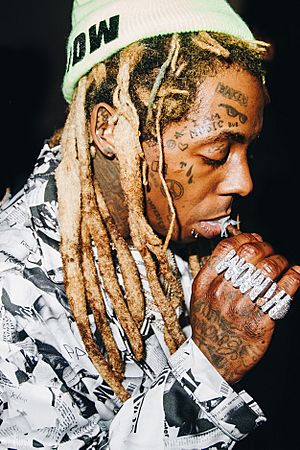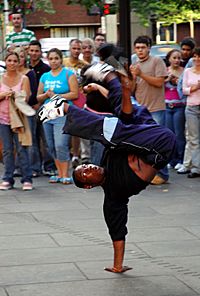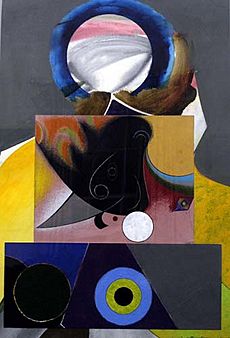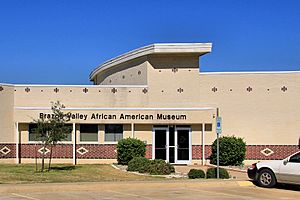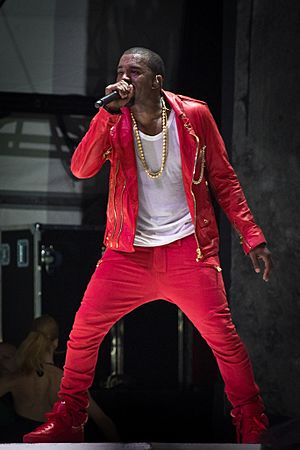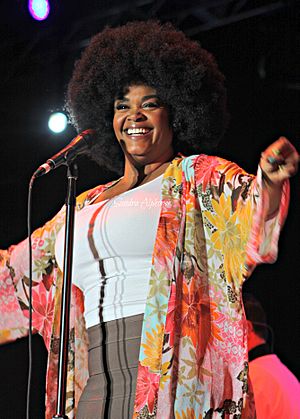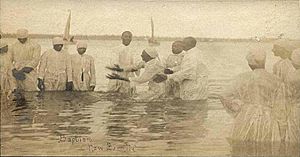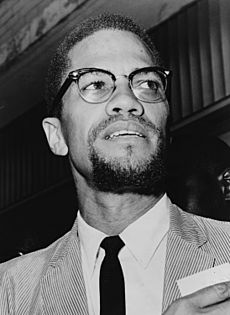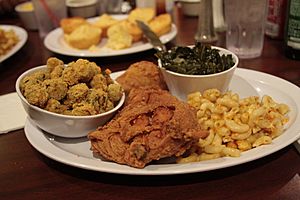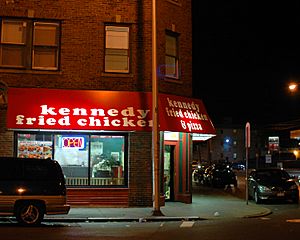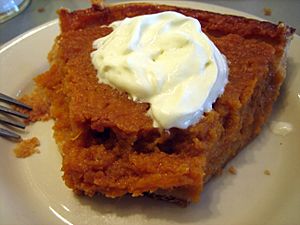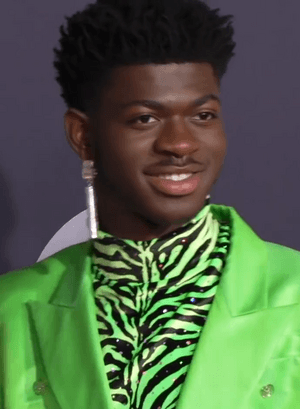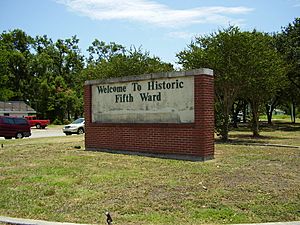African-American culture facts for kids
African-American culture is all about the amazing things African Americans have added to the United States. It's a mix of old African traditions, especially from West and Central Africa, and European influences. Even though slavery tried to erase their culture, many traditions, values, and beliefs survived. Over time, these blended with European and Native American cultures. This created a strong, unique culture that has deeply shaped America and the world.
Christianity has been a huge part of African-American culture. In the late 1700s, the Black church started because freed Black people didn't like being separated in white churches. The Black church became the heart of the American Civil Rights Movement. Black preachers led the way, encouraging education and economic growth. They often connected Black and white communities. Today, the Black church still supports its members and often focuses on social issues like poverty and racism.
After slavery ended, African-American traditions continued to grow in music, art, literature, religion, and food. For many years, this culture developed separately due to slavery and discrimination. But today, African-American culture has influenced American culture while still being its own special part.
Contents
History of African-American Culture
From the 1600s, slave owners tried to control enslaved people by taking away their African culture. But because enslaved Africans and their descendants were kept separate, they managed to keep many parts of their traditional culture alive. Slave owners tried to stop Black people from organizing politically or culturally. This was because of the many slave rebellions that happened in places like the United States, Brazil, and Haiti.
African cultures, slavery, rebellions, and the Civil Rights Movement have all shaped how African Americans practice religion, live in families, and act in politics and business. You can see Africa's influence in many ways: in language, music, hairstyles, fashion, dance, religion, food, and how people see the world.
In return, African-American culture has changed many parts of mainstream American culture. This mixing of cultures is called creolization. Over time, the culture of enslaved Africans and their descendants has had a huge impact on American culture and even world culture.
Stories and Speeches
Slave owners often stopped enslaved African Americans from getting an education. They feared it would make them want freedom. In the U.S., laws that denied slaves formal education likely helped keep a strong oral tradition alive. This was common in many African cultures that didn't rely on writing. Storytelling became the main way to pass down history, rules, and other cultural information. This was like the griot tradition in Africa, where storytellers kept history alive. Many of these cultural elements have been passed down through generations. Folktales helped African Americans inspire and teach each other.
Famous African-American folktales include trickster stories about Br'er Rabbit and hero tales like John Henry. The Uncle Remus stories helped bring these tales to a wider audience. Other important stories are "The Signifying Monkey" and the legend of "Stagger Lee."
The way African Americans tell stories and speak is still seen today. Black preachers often perform their sermons, using their voice, volume, and rhythm to show emotion. This style of preaching is unique. Call and response is another part of this tradition. It's when the audience responds to the speaker, often with "amen." This interaction is also found in blues and jazz music. Strong, exciting language is another part of this oral tradition, often heard in sermons.
When African Americans moved from the South to the North, some worried that their traditional folk culture would be lost. But anthropologists like Zora Neale Hurston found that these traditions weren't dying. Instead, they were changing and growing in new places.
Other parts of African-American oral tradition include "the dozens" (a game of playful insults), "signifying" (clever wordplay), and "trash talk." Many of these have become popular in mainstream American culture. Spoken-word poetry is another example of how this tradition has influenced modern culture. Rap music from the 1980s and beyond is also seen as an extension of African oral culture.
The Harlem Renaissance
The first big public recognition of African-American culture happened during the Harlem Renaissance. This was led by Alain Locke. In the 1920s and 1930s, African-American music, literature, and art became widely known. Writers like Zora Neale Hurston and Langston Hughes wrote about the African-American experience. Jazz, swing, and blues became popular American music styles. African-American artists like William H. Johnson and Aaron Douglas created unique artworks.
The Harlem Renaissance also saw more political involvement for African Americans. Groups like the Universal Negro Improvement Association and the National Association for the Advancement of Colored People (NAACP) were founded. The Nation of Islam, a religious movement, also began in the early 1930s.
The Black Arts Movement
The Black Power movement of the 1960s and 1970s came after the non-violent Civil Rights Movement. This movement promoted Black pride and unity. It was different from the Civil Rights Movement's focus on integration. It also inspired a new wave of African-American art and writing, called the "Black Arts Movement."
Popular artists like Nina Simone and The Impressions created music that showed the growing racial and political awareness. Important writers of this time included Nikki Giovanni, Haki Madhubuti, Amiri Baraka, and Sonia Sanchez.
A key part of the Black Arts Movement was bringing back the "African aesthetic." This meant celebrating a shared cultural feeling and ethnic pride, like during the Harlem Renaissance. The idea that "Black is beautiful" became popular. Natural hairstyles, like the afro, and African clothing, like the dashiki, became common. This encouraged personal pride and political awareness among African Americans.
Music
African-American music comes from the rhythmic music of African ethnic groups, especially from West and Central Africa. African oral traditions, kept alive during slavery, used music to share history, teach lessons, ease pain, and send messages. African-American music often includes call and response, syncopation (off-beat rhythms), percussion, improvisation (making it up as you go), and complex harmonies. During slavery, Africans in America mixed European hymns with African elements to create spirituals. The banjo was the first African-derived instrument made and played in the U.S. Slaveholders learned that enslaved Africans used drums to communicate.
Many African Americans sing "Lift Every Voice and Sing" along with, or instead of, the American national anthem, "The Star-Spangled Banner." This song was written in 1900 by James Weldon Johnson and John Rosamond Johnson. It helps African Americans remember past struggles and show unity and hope. The NAACP adopted it as the "Negro National Anthem" in 1919. Many Black children learn this song in school, church, or from their families.
In the 1800s, African-American music became popular in American society through minstrel shows. By the early 1900s, music styles from the African-American community had changed American popular music. With radio and records, ragtime, jazz, blues, and swing became popular worldwide. The 1920s became known as the Jazz Age. The early 1900s also saw the first African-American Broadway shows and films like Hallelujah!.
Rock and roll, doo wop, soul, and R&B grew in the mid-1900s. These styles became very popular with white audiences and influenced other music. In the 1970s, "the dozens" (rhyming insults) and West Indian "toasting" led to a new music style. In the South Bronx, the rhythmic street talk of "rapping" grew into the huge cultural force known as hip hop.
Modern Music
Hip hop and contemporary R&B became multicultural movements, but they remained important to many African Americans. The Black Arts Movement of the 1960s and 1970s also helped funk and later hip hop forms like rap, hip house, and new jack swing to grow. House music was created in Black communities in Chicago in the 1980s. African-American music has become much more accepted in American popular music in the 2000s. Modern artists continue to create new music and have also brought back older styles like neo soul and funk-inspired groups.
Famous modern African-American musicians include 50 Cent, Jay-Z, Alicia Keys, Usher, Mary J. Blige, Ne-Yo, Snoop Dogg, and Kanye West.
The Arts
Dance
African-American dance comes from the dances of hundreds of African groups brought to the Americas, as well as European folk dances. In African tradition, dance was part of everyday life and special events. Many of these traditions, like "get down" and "ring shouts," still exist in modern dance.
In the 1800s, African-American dance appeared in minstrel shows. These shows often made fun of African Americans. The first African-American dance to become popular with white dancers was the cakewalk in 1891. Later dances included the Charleston, the Lindy Hop, and the Jitterbug.
During the Harlem Renaissance, African-American Broadway shows like Shuffle Along helped make Black dancers famous. African-American dance forms like tap, which mixes African and European styles, became very popular thanks to dancers like Bill Robinson.
Modern African-American dance comes from these older forms and also from African and Caribbean dances. Groups like the Alvin Ailey American Dance Theater continue to develop this art form. American popular dance is also greatly influenced by African-American dance, especially hip-hop dance.
One unique African-American dance, turfing, came from social and political movements in Oakland, California. Turfing is a street dance that expresses feelings about the loss of Black lives, police brutality, and race issues. It shows Black identity, unity, peace, and thoughts on the state of Black people today.
Twerking is an African-American dance similar to dances from African countries like Côte d'Ivoire and Senegal.
Art
From its beginnings in slave communities to the end of the 1900s, African-American art has been a vital part of U.S. art. Between the 1600s and early 1800s, art included small drums, quilts, iron figures, and ceramic pots in the Southern U.S. These items were similar to crafts in West and Central Africa. At the same time, Black artists like Scipio Moorhead and Joshua Johnson created art in a European style.
In the 1800s, Harriet Powers made quilts in Georgia that are now considered some of the best examples of 19th-century Southern quilting. Later, the women of Gee's Bend developed a unique, bold quilting style. It was based on traditional African-American quilts with simple geometric shapes, similar to Amish quilts and modern art.
After the American Civil War, museums and galleries started showing more work by African-American artists. But cultural expression was still limited by European art styles and racial prejudice. To get their work seen, many Black artists traveled to Europe, where they had more freedom. It wasn't until the Harlem Renaissance that more white Americans started noticing African-American art in America.
In the 1920s, artists like Raymond Barthé, Aaron Douglas, Augusta Savage, and photographer James Van Der Zee became well-known. During the Great Depression, new chances came for these artists under the Works Progress Administration (WPA). Later, other groups like the Harmon Foundation helped Black artists. Augusta Savage, Elizabeth Catlett, Jacob Lawrence, and others showed their work in museums and built their reputations.
In the 1950s and 1960s, there were few widely known African-American artists. Despite this, The Highwaymen, a group of 27 Black artists from Florida, painted beautiful, quick scenes of Florida landscapes. They sold about 50,000 paintings from their car trunks directly to people, not galleries. They were "The Highwaymen." Discovered again in the mid-1990s, they are now an important part of American folk history. Their art is highly valued today.
The Black Arts Movement of the 1960s and 1970s was another time of renewed interest in African-American art. Many Black artists gained national fame, including Lou Stovall, Ed Love, Charles White, and Jeff Donaldson. Donaldson and other Black artists formed the Afrocentric group AfriCOBRA, which still exists. Sculptor Martin Puryear had a major show at the Museum of Modern Art in New York in 2007. Notable modern African-American artists include Willie Cole, David Hammons, Eugene J. Martin, and Kara Walker.
Literature
African-American literature started with the oral traditions of enslaved Africans in America. Enslaved people used stories and fables like they used music. These stories influenced early Black writers and poets in the 1700s, like Phillis Wheatley. These authors wrote powerful slave narratives.
During the early 1900s Harlem Renaissance, many authors and poets, like Langston Hughes and W. E. B. Du Bois, wrote about how to deal with discrimination in America. Writers during the Civil Rights Movement, like Richard Wright and James Baldwin, wrote about racial segregation and oppression. This tradition continues today with authors who are a key part of American literature. Works like Roots by Alex Haley, The Color Purple by Alice Walker, and Beloved by Nobel Prize winner Toni Morrison have won awards and become bestsellers.
Cinema
African-American films often have Black casts and are made for Black audiences. More recently, Black films feature diverse casts and aim for diverse audiences, even if the story is deeply about being Black in America.
Museums
The African-American Museum Movement started in the 1950s and 1960s. Its goal was to save the history of the African-American experience and make sure it was correctly shown in American history. Museums about African-American history are in many Black neighborhoods. Places like the African American Museum and Library at Oakland were created by African Americans to teach and explore cultural history that was mostly passed down orally.
Other important African-American museums include Chicago's DuSable Museum of African American History and the National Museum of African American History and Culture in Washington, D.C., which opened in 2003.
Language
Generations of hardship from slavery stopped African Americans from learning to read and write English. This led to unique language patterns. Slave owners often mixed people who spoke different African languages to prevent them from communicating in their native tongues. This, along with bans on education, led to the development of pidgins. These were simplified mixes of two or more languages that different speakers could use.
Examples of pidgins that became full languages include Creole, common in Louisiana, and Gullah, spoken on the Sea Islands off South Carolina and Georgia.
African-American Vernacular English (AAVE) is a dialect of American English closely linked to African Americans' speech. While AAVE is a real dialect with its own rules, some people see it as slang or poor English. Many African Americans born outside the South still speak with hints of AAVE or a Southern dialect. It's common for AAVE speakers to switch between AAVE and Standard American English depending on the situation.
Fashion and Style
Clothing
The Black Arts Movement of the 1960s brought together traditional African clothing with modern fashion. This created a unique African-American style. Kente cloth is a well-known African fabric. These colorful woven patterns, from Ghana and Togo, are used in many Western styles, from T-shirts to bow ties. Kente strips are often sewn into church robes or worn as stoles. Since the Black Arts Movement, traditional African clothing has been popular for both formal and casual events. Other African fashion elements in African-American culture include bright colors, mud cloth, and Adinkra symbols in jewelry.
Another common fashion aspect in African-American culture is dressing up for church. In most Black churches, people are expected to look their best for worship. African-American women are known for wearing bright dresses and suits. A Bible verse about covering one's head led to the tradition of wearing fancy Sunday hats, sometimes called "crowns."
Hip hop fashion is popular with African Americans. Grillz (dental jewelry) were made popular by rapper Nelly. Sagging pants were also part of African-American culture. Air Jordan shoes, named after basketball player Michael Jordan, are very popular.
African-American fashion designers include Sean Combs, Kimora Lee Simmons, Virgil Abloh, and Kanye West.
Hair
Hair styling in African-American culture is very diverse. African-American hair usually has coiled curls, from tight to wavy. Many women wear their hair naturally. Natural hair can be styled in many ways, like afros, twist-outs, and braid-outs. It's a myth that natural hair is hard to manage. For decades, mainstream culture tried to make Black women straighten their hair. Some women still prefer to straighten their hair with heat or chemicals. This can be a personal choice, but it's also because straight hair is often seen as the beauty standard in the West, and hair type can affect jobs. However, more and more women are wearing their hair naturally and getting positive reactions. For men, leaving their hair natural is common.
As men get older and lose hair, they often cut it very short or shave their heads. Since the 1960s, natural hairstyles like afros, braids, waves, fades, and dreadlocks have become more popular. Even though they were once linked to political movements and are different from mainstream Western styles, they are now more accepted.
Having facial hair is more common among African-American men than other men in the U.S. The "soul patch" was named because Black men, especially jazz musicians, made it popular. The preference for facial hair is partly personal taste. It's also because Black men are more likely to get "razor bumps," so many prefer not to shave.
Body Image
Sometimes, European Americans have adopted different hair braiding techniques and other African-American hair styles. There are also groups working to raise the standing of the African aesthetic among African Americans and globally. This includes promoting models with clear African features, making natural hairstyles mainstream, and celebrating fuller body types for women.
Religion
While African Americans practice many religions, Protestant Christianity is the most common (over 85%).
Christianity
The religious groups of African-American Christians are often called the Black church. During slavery, many enslaved people lost their African beliefs and were forced to become Christians. However, they managed to keep some African religious practices by mixing them into Christian worship during secret meetings. These practices, like dance, shouts, African rhythms, and lively singing, are still a big part of worship in the Black church.
African-American churches taught that all people were equal in God's eyes. They disagreed with the idea of obeying masters, which was taught in white churches. Instead, the Black church focused on equality and hope for a better future. Before and after emancipation, racial segregation led to the creation of organized African-American Christian groups. The first was the AME Church, founded by Richard Allen in 1787.
After the Civil War, three smaller Baptist groups joined to form the National Baptist Convention. This is the largest African-American Christian group. An African-American church doesn't have to be a separate denomination. Many Black churches are part of mostly white denominations. Black churches gave African Americans leadership roles and chances to organize that were denied in mainstream American society. Because of this, Black pastors became a link between Black and white communities and played a key role in the Civil Rights Movement.
Like many Christians, African-American Christians sometimes have or attend a Christmas play. Black Nativity by Langston Hughes tells the classic Nativity story with gospel music. These plays can be found in Black theaters and churches across the country.
Islam
Long before the Atlantic slave trade, Islam was a strong religion in West Africa. It spread peacefully through trade between African tribes and Arabs in North Africa. Many first-generation enslaved people kept their Muslim identity, but their descendants often couldn't. Enslaved people were either forced to become Christian or faced many difficulties practicing their religion.
After slavery, especially during the Great Depression, Islam reappeared in the African-American community through visible movements. The Moorish Science Temple of America was founded by Noble Drew Ali. Ali influenced Wallace Fard, who founded the Nation of Islam in 1930. Elijah Muhammad became its leader in 1934. Like Malcolm X, who left the Nation of Islam in 1964, many African-American Muslims now follow traditional Islam.
Many former Nation of Islam members became Sunni Muslims when Warith Deen Mohammed took over in 1975 and taught traditional Islam based on the Qur'an. A survey shows that 30% of Sunni Mosque attendees are African Americans. Most African-American Muslims are orthodox Muslims, with only 2% belonging to the Nation of Islam.
Judaism
About 150,000 African Americans in the U.S. practice Judaism. Some are part of mainstream Jewish groups like Reform, Conservative, or Orthodox Judaism. Others belong to non-mainstream groups like the Black Hebrew Israelites. The Black Hebrew Israelites are African-American religious groups whose beliefs come partly from Judaism. They often believe African Americans are descendants of the biblical Israelites.
Studies show a big increase in African Americans identifying as Jewish in the last 10-15 years. Rabbi Capers Funnye, Michelle Obama's first cousin, says, "I am a Jew, and that breaks through all color and ethnic barriers."
Other Religions
Besides Christianity, Islam, and Judaism, some African Americans practice Buddhism and other religions. A small but growing number of African Americans follow Syncretic Religions, like Voodoo, Santería, Hoodoo, and Ifá. Many are immigrants or descendants of immigrants from the Caribbean and South America, where these are practiced. Because of practices like animal sacrifice, which are not common in larger American religions, these groups can sometimes face negative views or harassment. However, a 1993 Supreme Court ruling protects their right to practice their religion.
In Louisiana, some African Americans practice Louisiana Voodoo.
No Religion
In a 2008 survey, 12% of African Americans said they had no particular religion (11%), were agnostic (1%), or atheist (less than 0.5%).
Life Events
For most African Americans, celebrating life events is similar to mainstream American culture. While Black and white Americans often lived separately for much of history, they generally shared similar views on American culture. However, some traditions are unique to African Americans.
Some African Americans have created new coming-of-age ceremonies linked to African traditions. Some pre-teen and teenage boys and girls take classes to prepare for adulthood. These classes often focus on spirituality, responsibility, and leadership. Many are based on traditional African ceremonies, emphasizing African cultures.
Today, some African-American couples choose to "jump the broom" as part of their wedding. Some say this practice comes from Ghana, while others argue it's more like a tradition from England. Although this tradition became less common after slavery, it has seen a small return as some couples want to connect with their African heritage.
Funeral traditions vary by religion and location, but there are common elements. The most important part of death in African-American culture is the gathering of family and friends. When someone is dying or has just died, friends and family are usually notified. This gathering provides emotional support and help with decisions.
The spiritual side of death is very important. A clergy member or religious community members are usually with the family. Death is often seen as a journey, not an end. Many services are called "homegoings" or "homecomings," based on the belief that the person is going home to the afterlife. The whole process is often a celebration of the person's life and achievements, rather than mourning. This is famously seen in New Orleans jazz funerals, where upbeat music, dancing, and food encourage celebration.
Food
Food is a key way to understand African-American culture, traditions, and community. How food was prepared and eaten since the time of slavery shows a lot about the identity of African-American culture. Derek Hicks talks about the origins of "gumbo," a soul food dish. He explains how food and culture are connected in the African-American community. There's no written history of gumbo recipes, so it was passed down orally, making it a truly communal dish. Gumbo is believed to be "an invention of enslaved Africans and African Americans" in Louisiana.
Many crops in the U.S., like yams, peanuts, rice, okra, and cotton, have African roots. African-American foods show creative ways to deal with hardship and poverty. During slavery, African Americans couldn't eat better cuts of meat. After emancipation, many were too poor to afford them. Enslaved African Americans would take leftover ingredients from their white owners, like less desirable meats and vegetables, and make them into dishes like stews or soups. Sharing this food in churches brought people together, sharing experiences, feelings, and a sense of unity.
Soul food, a hearty cuisine linked to African Americans in the South (but found nationwide), creatively uses inexpensive ingredients from farming and hunting. Pig intestines are boiled and sometimes fried to make chitterlings, or "chitlins." Ham hocks and neck bones flavor soups, beans, and boiled greens.
Other common foods, like fried chicken, fried fish, macaroni and cheese, cornbread, and hoppin' john (black-eyed peas and rice), are prepared simply. When more African Americans lived in rural areas, rabbit, opossum, and squirrel were important additions to their diet. Many of these food traditions are strong in the rural South.
Traditional soul food can be high in fat, sodium, and starch. While it was good for physically demanding lives, it now contributes to obesity, heart disease, and diabetes in a more urban population. As a result, more health-conscious African Americans are changing how they cook. They use natural vegetable oils instead of trans fats and smoked turkey instead of cured pork. They also limit sugar in desserts and eat more fruits and vegetables. But some resist these changes because they mean moving away from long-held cooking traditions.
Other soul foods include chicken and waffles, and desserts like banana pudding, peach cobbler, red velvet cake, and sweet potato pie. Kool-Aid is considered a soul food drink.
Okra came from Ethiopia and Eritrea. Rice, common in South Carolina and Georgia, came from Madagascar. Soul food is similar to gypsy cooking in Europe. The roots of soul food are found along the West Coast of Africa, including countries like Senegal and Nigeria, and also in Western European countries like Scotland. But its flavors are found all over America.
Holidays and Celebrations
African Americans celebrate ethnic holidays along with traditional American holidays. Some holidays observed by African Americans are now widely considered American holidays. The birthday of civil rights leader Martin Luther King Jr. has been a national holiday since 1983.
Black History Month is another African-American observance adopted nationally. It's even required by law in some states. Black History Month focuses on parts of American history that were often ignored, especially the lives and stories of African Americans. It's celebrated in February to match the founding of the NAACP and the birthdays of Frederick Douglass (a famous abolitionist) and Abraham Lincoln (the president who signed the Emancipation Proclamation).
On June 7, 1979, President Jimmy Carter declared June as Black Music Month. For years, presidents have recognized Black Music Month (also called African-American Music Month) as a key part of American heritage. It's celebrated with events that highlight many forms of music, from gospel to hip-hop. Black musicians, singers, and composers are also honored for their contributions.
Less widely known outside the African-American community is Emancipation Day, also called Juneteenth or Freedom Day. It marks the official reading of the Emancipation Proclamation on June 19, 1865, in Texas. Juneteenth is a day for African Americans to reflect on their unique history. It's one of the fastest-growing African-American holidays. Juneteenth became a federal holiday in 2021.
Another holiday not widely celebrated outside the African-American community is Malcolm X's birthday on May 19. It's observed in American cities with many African Americans, including Washington, D.C.
Kwanzaa is another important African-American holiday. Like Emancipation Day, it's not widely observed outside the African-American community, but it's growing in popularity. African-American scholar Maulana Karenga created Kwanzaa in 1966 as an alternative to the growing commercialization of Christmas. Based on African harvest rituals, Kwanzaa is celebrated from December 26 to January 1. People celebrating Kwanzaa affirm their African heritage and the importance of family and community. They drink from a unity cup, light red, black, and green candles, exchange African art, and remember those who fought for African and African-American freedom.
Names
While many African-American names are common in the U.S., unique naming trends have emerged. Before the 1950s and 1960s, most African-American names were similar to European American names. A big change in naming began in the 1960s and 1970s. With the Civil Rights Movement, names from various origins became popular. People started using neo-African or Islamic names. Efforts to rediscover African heritage inspired names with deeper cultural meaning. Before this, African names were rare because enslaved people were often given their enslavers' European names.
African-American names come from many languages, including French, Latin, English, Arabic, and African languages. The Muslim religion greatly influenced African-American names. Islamic names became popular with the rise of the Nation of Islam and its focus on civil rights. The name "Aisha" comes from the Qur'an. Many Muslim names like Jamal and Malik became popular simply because they were fashionable, and many are now used by African Americans regardless of their religion. African names also started appearing, like Ashanti, Tanisha, and Aaliyah.
By the 1970s and 1980s, it was common to invent new names, often using parts of popular existing names. Prefixes like La/Le-, Da/De-, Ra/Re-, or Ja/Je- and suffixes like -ique/iqua, -isha, and -aun/-awn are common, as well as creative spellings for common names.
Even with the rise of creative names, it's still common for African Americans to use biblical, historic, or European names.
Family Life
During slavery in the U.S., families were often separated by sale. But even then, many African-American families kept strong bonds. Free Black men and women who bought their freedom or escaped often worked hard to buy and send for their family members who were still enslaved.
Others, separated from blood relatives, formed close bonds with "play" family members, like "play" aunts and cousins. This practice, from African oral traditions, continued after slavery. Non-blood friends are often given the titles of relatives. This wider idea of family and community, and deep respect for elders, might be why terms like "cousin," "aunt," "uncle," and "Mama" are used when addressing other African Americans, even strangers.
African-American Family Structure
Right after slavery, African-American families worked to reunite. As late as 1960, when most African Americans lived under segregation, 78% of Black families were headed by married couples. This number dropped in the late 1900s. For the first time since slavery, most African-American children live with only one parent, usually the mother.
This change is balanced by support systems from extended family members. Older family members pass on traditions like religion and manners to younger ones. In return, younger family members care for older ones when they need help. These relationships exist at all economic levels in the African-American community, providing strength and support.
African Americans are less likely to own a pet.
Marriages between different races have increased for African Americans since the Loving v. Virginia court case.
Fifty-six percent of African-American children are born to unmarried mothers. African-American parents are often strict and have high standards for behavior. In 1998, 1.4 million African-American children lived in a grandparent's home.
Politics and Social Issues
Since the Voting Rights Act of 1965, more African Americans are voting and being elected to public office. As of 2008, the U.S. had about 10,000 African-American elected officials. African Americans mostly support the Democratic Party. Only 11% of African Americans voted for George W. Bush in the 2004 Presidential Election. In 2016, only 8% voted for Republican Donald Trump, while 88% voted for Democrat Hillary Clinton.
Social issues like racial profiling, unfair sentencing, higher poverty rates, less access to healthcare, and racism in institutions are important to the African-American community. While there are big differences on racial and money issues, African Americans generally have the same hope and concern for America as other groups.
African Americans can express political and social feelings through hip-hop culture, including graffiti, break-dancing, and rapping. This cultural movement comments on past and present topics like street culture and incarceration, often calling for change. Hip-hop artists play a big role in activism and fighting social injustices.
Some leaders in the Black church have spoken out against gay rights issues like gay marriage. But others in the African-American community, like Coretta Scott King and Reverend Al Sharpton, have different views. Sharpton once said he supported gay marriage as much as he supported Black marriage or white marriage.
Black LGBT Culture
The Black LGBT community refers to African Americans who are also part of the LGBT community. They often face challenges both because of their race and their identity. Surveys show that 80% of African Americans believe gay and lesbian people face discrimination, compared to 61% of white people. Black LGBT individuals have always had to deal with racism and homophobia.
Black LGBT people became more visible during the Harlem Renaissance. A subculture of LGBTQ African-American artists and entertainers emerged. This included people like Alain Locke, Langston Hughes, Bessie Smith, and Gladys Bentley. Places like the Savoy Ballroom hosted drag-ball events with costume prizes. Historian George Chauncey noted that during this time, "perhaps nowhere were more men willing to venture out in public in drag than in Harlem."
African-American Neighborhoods
African-American neighborhoods are types of communities found in many U.S. cities. Their creation is closely linked to the history of segregation in the United States, either by law or social rules. Despite this, African-American neighborhoods have been very important in developing almost all parts of both African-American culture and wider American culture.
Wealthy African-American Communities
Many wealthy African-American communities exist today. These include Woodmore, Maryland; Hillcrest, New York; Redan and Cascade Heights, Georgia; Mitchellville, Maryland; Converse, Texas; Missouri City, Texas; DeSoto, Texas; Quinby, South Carolina; Forest Park, Oklahoma; and Mount Airy, Pennsylvania.
Ghettos
Because of segregation and widespread poverty, some African-American neighborhoods have been called "ghettos." This term can be controversial and sometimes offensive. While mainstream America uses "ghetto" to mean a poor urban area with minorities, people living there often used it positively. African-American ghettos didn't always have run-down houses or poor residents. For many African Americans, the ghetto was "home." It represented true "blackness" and a feeling of overcoming struggles.
Langston Hughes wrote in "The Heart of Harlem" (1945): "The buildings in Harlem are brick and stone/And the streets are long and wide,/But Harlem's much more than these alone,/Harlem is what's inside." Playwright August Wilson used the term "ghetto" in his plays, drawing on his experience growing up in the Hill District of Pittsburgh, an African-American neighborhood.
African-American neighborhoods might suffer from less investment in public services like schools and police. But institutions like churches, museums, and political groups help improve these neighborhoods. In Black neighborhoods, churches can be important for community unity. For some African Americans, the spirituality learned through these churches helps protect against the harmful effects of racism. Museums about African-American history are also found in many Black neighborhoods.
Many African-American neighborhoods are in "inner cities," close to downtown areas. The buildings are often row houses or brownstones, mixed with older single-family homes converted to multi-family homes. Some areas have larger apartment buildings. Shotgun houses are an important part of some Southern African-American neighborhoods. These houses have three to five rooms in a row with no hallways. This design is found in both rural and urban Southern Black communities.
Social Connections
There are African-American social networking websites like BlackPlanet. Social media is an important way for African Americans to engage in politics. African-American teenagers are the biggest users of Instagram and Snapchat.
Images for kids
See also
 In Spanish: Cultura afroestadounidense para niños
In Spanish: Cultura afroestadounidense para niños




